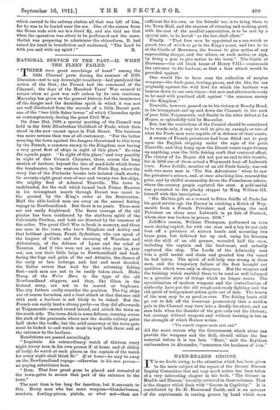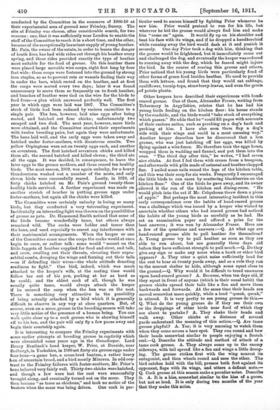HAND-RE4RED GROUSE.
IT is no doubt owing to the attention which has been given to the main subject of the report of the Grouse Disease Inquiry Committee that not very much notice has been taken of a very interesting chapter in the book, " The Grouse in Health and Disease," recently reviewed in these columns. That is the chapter which deals with " Grouse in Captivity." It is contributed by Dr. H. Hammond Smith, and is an account of the experiments in rearing grouse 4'hand which were conducted by the Committee in the summers of 1906-10 at their experimental area of ground near Frimley, Surrey. The site at Frimley was chosen, after considerable search, for two reasons : one, that it was sufficiently near London to enable the staff of the Committee to reach it in a short time, and the other, because of the exceptionally luxuriant supply of young heather. Mr. Pain, the owner of the estate, in order to lessen the danger of heath fires, has had wide rides cut through his heather every spring, and these rides provided exactly the type of heather most suitable for the food of grouse. On this heather there were placed large movable wire coops, eight feet long by four feet wide : these coops were fastened into the ground by strong iron staples, so as to prevent rats or weasels finding their way in under the bars, which rested on the heather, and at first the coops were moved every two days; later it was found unnecessary to move them so frequently on to fresh heather, and bunches of heather were tied on the wire for the birds to feed from—a plan which answered perfectly well. The first year in which eggs were laid was 1907. The Committee's stock of birds had been reduced by various casualties to a single pair. The hen, however, laid nine eggs after being mated, and hatched out four chicks ; unfortunately two escaped and two died. The next year, however, more birds were obtained, and the Committee started their experiments with twelve breeding pairs, but again they were unfortunate. The hens laid well, and the early eggs were taken away and batched under foster-mothers, with disastrous results. Two yellow Orpingtons were set on twenty eggs each, and another on seventeen. The first hatched seventeen chicks and killed them all; the second hatched and killed eleven ; the third ate all the eggs. It was decided, in consequence, to leave the later eggs to the grouse mothers, and these reared ten healthy birds. The next season, 1909, was again unlucky, for a heavy thunderstorm washed out a number of the nests, and only eleven birds were successfully reared. Lastly, in 1910, of forty chicks hatched on Mr. Pain's ground twenty-three healthy birds survived. A further experiment was made on another stretch of heather in putting grouse eggs under foster-mothers, but again all the chicks were killed.
The Committee were certainly unlucky in losing so many birds, but they conducted a very interesting experiment. Incidentally an interesting light was thrown on the possibilities of grouse as pets. Dr. Hammond Smith noticed that some of the birds became wonderfully tame, but others always remained wild. The cocks were bolder and tamer than the hens, and used especially to resent any interference with their matrimonial arrangements. When the keeper or one of the Committee came near the coops the cocks would at once begin to crow, or rather talk : some would mount on the little faggots of heather• supplied for food and strut, and talk, and crow, swelling out their throats, elevating their supra- orbital combs, drooping the wings and fanning out their tails —as if defending their wives—the whole attitude denoting readiness to fight." One bird, indeed, which was much attached to the keeper's wife, at the mating time would follow her out of his pen, pecking at her• as hard as he could; and the oldest cock of all, though he was usually quite tame, would always attack the keeper if he entered the coop when the hen was on the nest. There is something very attractive in the possibility of being actually attacked by a bird which it is generally difficult to observe in any way at close quarters. But, of course, even on a moor, grouse in the breeding season will take very little notice of the presence of a human being. You can walk quite close up to a cock grouse who is showing himself off to his hen, and the pair will only fly a few paces away and begin their courtship again.
It is interesting to compare the Frimley experiments with some earlier attempts at breeding grouse in captivity which
were chronicled some years ago in the Gamekeeper. Lord
Henry Bentinck's head keeper, W. Prior, at Deeside, near Sedbergh, in Yorkshire, in 1898 set forty-six grouse eggs under four hens—a game hen, a cross-bred bantam, a rather heavy h en of uncertain breed, and a bird mostly Minorca. In odd con- trast to the Frimley failures with foster-mothers, Mr. Prior's hens behaved very fairly well. Thirty-two chicks were hatched, and though a few were lost the rest were successfully brought along, and eventually turned out on the moor. They then became " as tame as chickens," and took no notice of the beaters when the moor was being driven. One cock in par- ticular used to amuse himself by fighting Prior whenever he saw him. Prior would pretend to run for his life, but wherever he hid the grouse would always find him and make him "come on" again. It would fly up on his shoulder and beat his face with its wings, and if he dropped a handkerchief while running away the bird would dash at it and punish it severely. One day Prior took a dog with him, thinking that the grouse would be frightened, but it immediately came out and challenged the dog, and eventually the keeper was reduced to running away with the dog, which he feared might injure the bird. In the course of rearing this grouse and others, Prior• noticed that his young birds were particularly fond of other forms of green food besides heather. He used to provide them with lettuce, and found that they would eat cabbage, cauliflower, turnip-tops, strawberry-leaves, and even the green of potato plants.
Other keepers have described their experiences with hand- reared grouse. One of them, Alexander Fraser, writing from Tober•mory in Argyllshire, relates that he has had his young birds feeding on the kitchen floor: his house stands by the roadside, and the birds would "take stock of everything which passes." He adds that he "could fill pages with accounts of their curious antics, such as perching on a dog's back and pecking at him. I have also seen them flap a dog's side with their wings and scold in a most amusing way." Another keeper describes bow he discovered that a hen grouse, who was just hatching off her eggs, was killed by flying against a wire fence. He therefore took the eggs home, wrapped them in wadding and flannel, and put them into the oven. " The third day after this," he writes, "I had seven nice chicks. At first I fed them with cream from a teaspoon, and afterwards with pills made of oatmeal and heather chopped fine. I nailed some rails round the legs of the kitchen table, and this was their coop for six weeks. Frequently I encouraged the little birds to run races by scattering blackberries on the kitchen floor." One of the birds be gave away, and its owner allowed it the run of the kitchen and dining-room. " He would pitch into the cat if Mr. Colquhoun threw down a piece of apple." But perhaps the most interesting incident in this early correspondence over the habits of hand-reared grouse was a challenge which was issued by a keeper who wished to ascertain whether others who had reared grouse had noticed the habits of the young birds as carefully as he had. He set an examination paper and offered a prize for the best answers; it was won by Alexander Fraser. Here are a few of the questions and answers :—Q. At what age are hand-reared grouse able to pull heather for themselves P A. Young grouse try to pull heather as soon as they are able to run about, but are generally three days old before they have sufficient strength to pull much.—Q. Do they give any sign or make any noise when a hawk or other bird appears P A. They utter a quiet noise sufficiently loud for the rest to hear at twenty yards away, and as a rule they run to the nearest shelter to hide, although some squat close to the ground.—Q. Why would it be difficult to tread unawares upon hand-reared grouse P A. Because, when ten days old, if they squat in front of anyone (which is their usual habit) the grouse chicks spread their tails like a fan and move them backwards and forwards. At the same time their heads are moved somewhat more quickly, while a loud "queak, queak," is uttered. It is very pretty to see young grouse do this.— Q. What do the young grouse do if they see their own or the droppings of other birds near food of which they are about to partake P A. They shake their heads and walk away. Other chicks at a distance of several yards understand the meaning of this action.—Q. Are tame grouse playful? A. Yes; it is very amusing to watch them when they come across a bare spot. They ran round and bow their heads somewhat similar to people enjoying a Scotch ' reel.—Q. Describe the attitude and method of attack of a tame cock grouse. A. They always come up to the enemy sideways, with tail spread like a fan and wings a little droop- ing. The grouse strikes first with the wing nearest its antagonist, and then wheels round and uses the other. The bird catches hold with the bill, presses both feet against its opponent, flaps with its wings, and utters a defiant note.--. Q. Cock grouse at this season make a peculiar noise. Describe it. A. It is a bias, somewhat similar to the hiss of a goose, but not so loud. It is only during two months of the year that they make this noise.











































 Previous page
Previous page